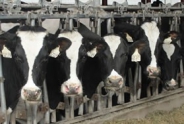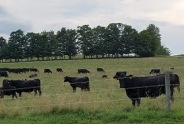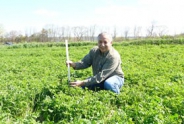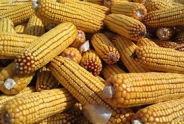Forage Quality
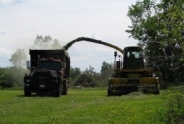 Knowing when to start first cutting haycrop can be a challenge. Harvest can not be tied to a particular calendar date but instead is dependent on heat and soil moisture. Alfalfa height has proven to be the best indicator of alfalfa and grass quality in the field and can give producers a heads up as to when to harvest.
Knowing when to start first cutting haycrop can be a challenge. Harvest can not be tied to a particular calendar date but instead is dependent on heat and soil moisture. Alfalfa height has proven to be the best indicator of alfalfa and grass quality in the field and can give producers a heads up as to when to harvest.To give producers some idea of when to start harvesting first cutting, the CNY Dairy, Livestock and Field Crops Team staff measures alfalfa height on over 55 fields across the eight counties. Those locations were chosen to reflect the diversity of heat, elevation, and soil moisture found in our area.
FORAGE QUALITY CATEGORIES
Field Crop Update June 5, 2025
Erik Smith, Area Field Crop Specialist/Team Leader
Central New York Dairy and Field Crops
Last Modified: June 5, 2025
Field Crop Update May 21, 2025
Erik Smith, Area Field Crop Specialist/Team Leader
Central New York Dairy and Field Crops
Last Modified: May 21, 2025
Field Observations, First Cutting Forage Quality, and Growing Degree Days (returning next week)
Field Crop Update May 13, 2025
Erik Smith, Area Field Crop Specialist/Team Leader
Central New York Dairy and Field Crops
Last Modified: May 14, 2025
1st Cutting Forage Quality Update ~ May 21, 2024
Erik Smith, Area Field Crop Specialist/Team Leader
Central New York Dairy and Field Crops
Last Modified: May 21, 2024
1st Cutting Forage Quality Update ~ May 14, 2024
Erik Smith, Area Field Crop Specialist/Team Leader
Central New York Dairy and Field Crops
Last Modified: May 14, 2024
1st Cutting Forage Quality Update ~ May 7, 2024
Erik Smith, Area Field Crop Specialist/Team Leader
Central New York Dairy and Field Crops
Last Modified: May 7, 2024
1st Cutting Forage Quality ~ April 29
Erik Smith, Area Field Crop Specialist/Team Leader
Central New York Dairy and Field Crops
Last Modified: April 30, 2024
1st Cutting Forage Quality Update ~ May 16, 2023
Erik Smith, Area Field Crop Specialist/Team Leader
Central New York Dairy and Field Crops
Last Modified: May 17, 2023
1st Cutting Forage Quality Update ~ May 8, 2023
Erik Smith, Area Field Crop Specialist/Team Leader
Central New York Dairy and Field Crops
Last Modified: May 9, 2023
1st Cutting Forage Quality Update ~ April 26, 2023
Erik Smith, Area Field Crop Specialist/Team Leader
Central New York Dairy and Field Crops
Last Modified: May 5, 2023
1st Cutting Forage Quality Update ~ May 3, 2023
Erik Smith, Area Field Crop Specialist/Team Leader
Central New York Dairy and Field Crops
Last Modified: May 5, 2023
1st Cutting Forage Quality Update ~ May 24, 2022
Erik Smith, Area Field Crop Specialist/Team Leader
Central New York Dairy and Field Crops
Last Modified: May 25, 2022
Upcoming Events
Labor Roadshow IX
December 1, 2025
December 9 - December 10, 2025December 17 - December 18, 2025December 22, 2025
In-person and online events to keep NY's agricultural employers informed and prepared for today's labor challenges.
Inspired by Annie's: How to Be a Strong Woman Farm Manager
December 10, 2025
December 17, 2025
Free webinars geared towards women who own or operate a farm in NYS.
2026 Dairy Day
January 13, 2026 : Dairy Day - Hamilton
Hamilton, NY
Lunch included
January 14, 2026 : Dairy Day - Ballston Spa
Ballston Spa, NY
Lunch included
Announcements
Statewide Field Crop Pathology Needs Assessment Survey
Your input is wanted for identifying priorities!Please take a moment to fill out this brief and anonymous survey that will guide the Field Crops Pathology Research and Extension program.
Sign Up for Our Weekly E-Newsletter
We send out a bi-weekly e-newsletter that has announcements, upcoming programs, and opportunities for you! Registration is quick, easy, and free. Click here to sign up today!Farmers Can Join MeatSuite For Free!
MeatSuite.com is a free resource provided by Cornell University where NY meat farmers can create a farm profile and list their bulk (wholes, halves, quarters) and bundled (i.e. Grilling Bundle) meat products.Why should farmers join?
1. It's free and easy!
2. Connect with more local customers. In the past year the MeatSuite.com farm directory had 8,300 visits from New York consumers. Farm profiles get as many as 25 views per month from potential local customers. We also spotlight MeatSuite farms on social media and bring attention and purchases to farms through highlights and giveaways.
How do I join?
Farmers can visit https://www.meatsuite.com/farmers/ to create a free farm profile. You must list at least one product for your farm's profile to go live. You'll also have access to Cornell's free Meat Price Calculator, a helpful tool for pricing your meat to make a profit.
While you're on MeatSuite, check out the "Creating Consumer-Friendly Bulk Meats" publication on the log-in page. It has tips on how to create bulk meat products that are easier for first-time buyers to say "yes" to.
If you have any questions as you create your farm profile or products, we're here to help! Please email Matt LeRoux at mnl28@cornell.edu.

